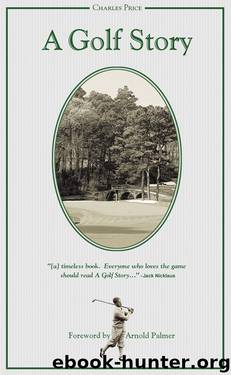A Golf Story by Charles Price

Author:Charles Price [Price, Charles]
Language: eng
Format: epub
Publisher: Triumph Books
Published: 2012-09-03T05:00:00+00:00
Mackenzie’s original sketch for the course. Many changes would be made to it. Alston & Bird.
To begin with, the fifth hole was somewhat longer than it now is, calling for a par of five.
The sixth was also longer by about twenty-five yards, but would have still been a par-three.
Par at the seventh would have remained at four, but the hole was much shorter and easier, its green lying in that part of the fairway where a pro could easily drive with today’s ball.
Another hole that was much shorter was the tenth, the green for which lay below the fairway bunker that is there now.
At the top of the hill, near where the tenth green is today, was the eleventh tee.
The thirteenth hole was slightly shorter, and would have been just over the borderline as a par-five, as it still is, now that it has been lengthened and the USGA’s standards have grown longer.
The fourteenth had a fairway bunker that has since been removed.
The fifteenth was much shorter and would have played to a par of four.
The sixteenth was much shorter, but the seventeenth was much longer, playing off the tee into what is now fifteen’s fairway. You then approached the green from the right of the bunker that now sits in front of it, giving the hole a par of five.
Eighteen would have played much as it does today, except that the fairway bunkers would not be put in until much later.
But at eighteen, you weren’t finished! Mackenzie had designed a nineteenth hole—literally. From the eighteenth green, you walked to the left and slightly down the hill toward what would become a practice range. You then played a short par-three up the hill to the right of the manor house. The green would have been where the gigantic practice putting green now is.
Ridiculous as such a hole seems today, there had been a precedent for Mackenzie’s nineteenth. It was known previous to Augusta National as a “bye hole,” and might not only have been tacked on to the eighteenth but shoehorned in somewhere along the back nine, say, between the sixteenth green and the seventeenth tee, where the original course at Congressional Country Club, outside Washington, D.C., and where Tommy Armour had been the pro, then had one. The point of the hole was to allow for an extra wager, in Augusta National’s case perhaps to play for double or nothing.
Whatever the purpose, the hole was never built, probably because Jones thought it interfered with the symmetry of the course. It was too disproportionate, too out of harmony with the classicism he was after.
Mackenzie’s contribution to Augusta National was now largely finished. Jones would take over from here—in the fall, winter, and spring of 1931–32. He would hit hundreds upon hundreds of experimental shots to see if each fairway had the sweep he was after, if every bunker struck just the right amount of fear in the heart, if every green accepted a well-hit shot and rejected a poor one.
Download
This site does not store any files on its server. We only index and link to content provided by other sites. Please contact the content providers to delete copyright contents if any and email us, we'll remove relevant links or contents immediately.
| African Americans | Civil War |
| Colonial Period | Immigrants |
| Revolution & Founding | State & Local |
Cat's cradle by Kurt Vonnegut(15113)
Pimp by Iceberg Slim(14234)
4 3 2 1: A Novel by Paul Auster(12234)
Underground: A Human History of the Worlds Beneath Our Feet by Will Hunt(11986)
The Radium Girls by Kate Moore(11877)
Wiseguy by Nicholas Pileggi(5618)
Perfect Rhythm by Jae(5283)
American History Stories, Volume III (Yesterday's Classics) by Pratt Mara L(5218)
The Fire Next Time by James Baldwin(5207)
Paper Towns by Green John(5030)
Pale Blue Dot by Carl Sagan(4867)
A Higher Loyalty: Truth, Lies, and Leadership by James Comey(4803)
The Mayflower and the Pilgrims' New World by Nathaniel Philbrick(4383)
The Doomsday Machine by Daniel Ellsberg(4380)
Killers of the Flower Moon: The Osage Murders and the Birth of the FBI by David Grann(4353)
The Sympathizer by Viet Thanh Nguyen(4269)
Too Much and Not the Mood by Durga Chew-Bose(4237)
The Borden Murders by Sarah Miller(4197)
Sticky Fingers by Joe Hagan(4071)
